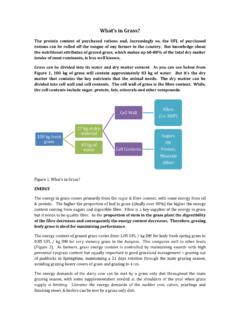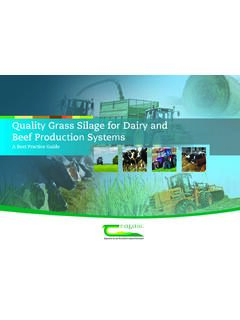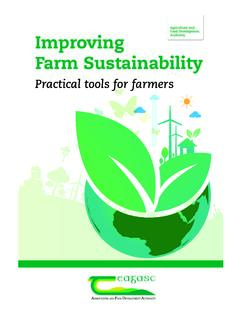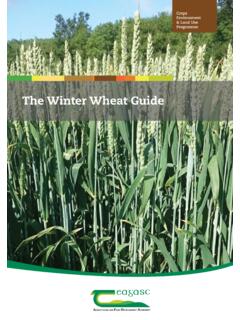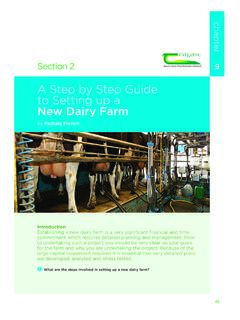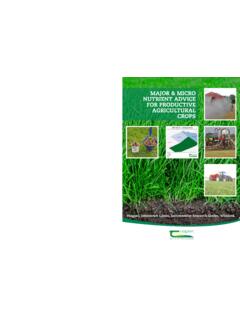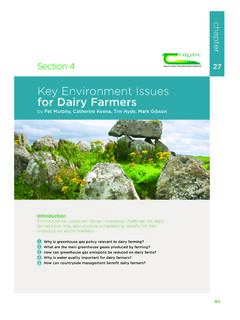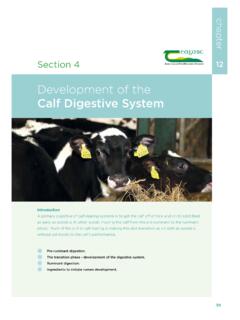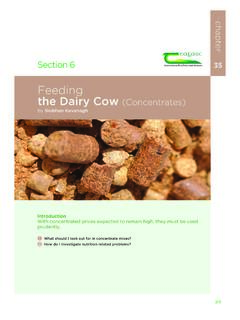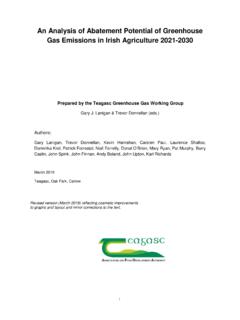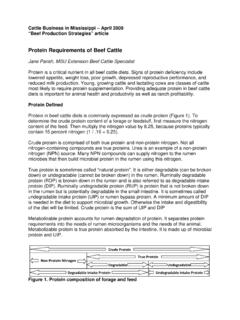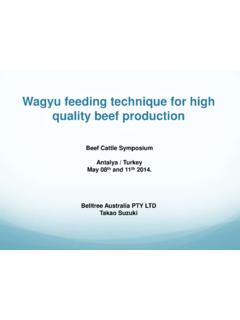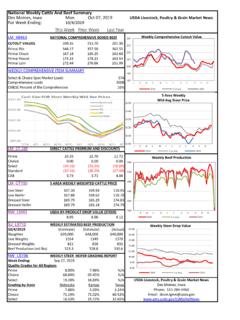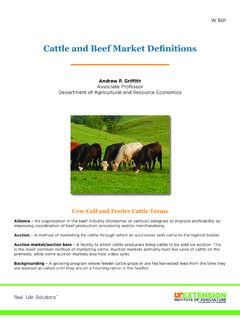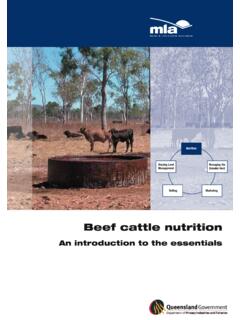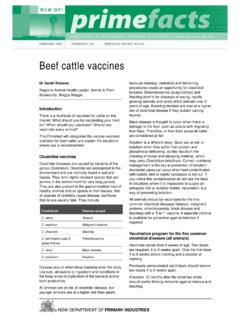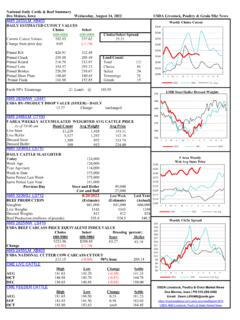Transcription of BEEF PRODUCTION SYSTEM GUIDELINES - Teagasc
1 beef PRODUCTION SYSTEM GUIDELINESA nimal & Grassland Research & Innovation ProgrammeBEEF PRODUCTION SYSTEM the author and Teagasc have made reasonable efforts to ensure that the information in this book was correct at time of going to press, the author and Teagasc do not assume and hereby disclaim and liability to any party for any loss, damage, or disruption caused by errors or omissions, whether such errors or omissions result from negligence, accident, or any other cause. Reasonable efforts have also been made to ensure the reliability of websites listed in this publication but inclusion of these cannot be taken as an endorsement of these sites. INTRODUCTION 03 Under 16 Month Bull beef (Suckler) (High Concentrate) 04 Under 16 Month Bull beef (Suckler) 06 Under 16 Month Bull beef (Dairy Calf to beef ) 0818 - 20 Month Suckler Bull beef 1018 -20 Month Bull beef (Dairy Calf to beef ) 1219 Month Early Maturing Heifer beef (Dairy Calf to beef ) 1420 Month Heifer beef (Suckler Bred) 1620 Month Steer beef (Suckler Bred) 1823 Month Early Maturing Steer beef (Dairy Calf to beef ) 2024 Month Heifer beef (Suckler) 2224 Month Steer beef (Suckler) 2424 Month Friesian Steer beef (Dairy Calf to beef ) 2626 Month Early Maturing Steer beef (Dairy Calf to beef ) 2828 Month Steer beef (Suckler)
2 PRODUCTION SYSTEM GUIDELINESINTRODUCTIONBEEF PRODUCTION SYSTEM GUIDELINESBeef farming in Ireland is characterised by many different beef PRODUCTION systems where cattle are sold off farms for further finishing on another farm or else are sold direct to national suckler herd supplies a significant proportion of the cattle slaughtered each year but with an expanding national dairy herd there is an increasing supply of calves of dairy origin that are being finished as beef . Both early and late maturing beef sires are used on suckler and dairy cows which also influences their age at slaughter and their carcass weights. In recent years, a considerable proportion of male beef animals are being finished as bulls at varying ages and weights. These systems are very different to the traditional steer finishing systems practiced on many one beef PRODUCTION SYSTEM is the optimum SYSTEM for finishing beef cattle with each having its own merits and risks.
3 For any beef SYSTEM to be profitable and sustainable in the long term there are a number GUIDELINES and targets that beef farmers need to be aware of and should work towards achieving. It is also important that beef farmers focus on the areas within their chosen beef SYSTEM that they can improve on over time instead of moving from one beef SYSTEM to another as a reaction to short term changes in the market. At the beef Industry Roundtable Discussions chaired by the Minister for Agriculture, Food and the Marine one of the key actions agreed was that Teagasc and Bord Bia would produce a set of GUIDELINES for beef farmers to follow when targeting a particular beef SYSTEM . These GUIDELINES were to include best practice around the management to achieve target daily gains, an estimate of the inputs required and the outputs achievable, an awareness of the different market requirements that the beef would be sold into and the risks involved, if any, associated with each publication outlines 14 of the most common beef systems on Irish farms at present.
4 It includes both suckler and dairy calf to beef systems. As the PRODUCTION of the suckler calf up until it is weaned from the cow is quite similar this stage of the PRODUCTION cycle is not covered under each SYSTEM , with an assumed common weaning weight for male and female calves of 320kg and 290kg liveweight, respectively. Similarly, the first 10 to 12 weeks rearing phase of the dairy calf is not included with an assumed common weaned calf weight of 90-100kg liveweight. Both these phases of PRODUCTION (for the suckler calf and the dairy bred calf ) are extremely important and can have a significant influence on the subsequent lifetime performance of an animal. For suckler farmers selling their calves shortly after they are weaned, the profitability of their SYSTEM is hugely influenced by the weight and quality of the calf that they sell due to the very high costs of keeping the suckler cow for a year and where the majority of their output is the value of the calf each cow rears.
5 The cost of keeping the suckler cow will depend to large extent on the length of the grazing season which is heavily influenced by land type and weather. Where the winter housing period is extended these costs are considerably higher when compared to drier farms with longer grazing seasAll of the performance data and estimates of inputs and outputs outlined for each SYSTEM is based on data generated from Teagasc research in Grange Research Centre and Johnstown Castle. It also includes data verified in Teagasc research demonstration herds such as the Derrypatrick herd in 90% of Irish beef PRODUCTION is exported. Exports exceed 500,000 tonnes annually, making Ireland the largest net exporter of beef in the EU and fourth largest in the world. Nowadays, over 95% of Irish beef exports are focused on the higher value consumer markets of the UK and continental Europe. The vast majority of these exports are in the form of boneless primal cuts.
6 After deboning, beef cuts from an individual carcase are supplied to several different customers, according to market demand. Irish beef is supplied to over 85 EU supermarket chains, as well as major manufacturing and foodservice customers, who have specific requirements with regard to the type of beef that they buy. With this in mind, PRODUCTION systems need to supply prime beef which meets the demands of our most important industry has developed a Quality Payment Scheme (QPS) which delivers a bonus payment on top of the quoted base price to producers who deliver steers, heifers and young bulls that meet the specifications laid out in table 1 below. It is important to realise that not all the PRODUCTION systems outlined will qualify for the QPS because animals may not meet the age, conformation, fat score or quality assurance criteria laid down at the time of slaughter. It is also the casewhere not all processors will pay a QPS on Under 16 month bulls so producers should consult with their processor.
7 It is advisable if producing animals outside of target market specifications, producers should be in communication with their processors. These SYSTEM GUIDELINES have been developed by Teagasc cattle specialists and beef researchers in association with Bord Bia beef market BULLMUST BE QUALITY ASSUREDU30m2+to 4=O=or betterMax. 470 days +U30m2+to 4=O=or betterMax. 470 days +U16m2+to 4=O=or betterMax. 470 days +Age:Fat Score:Conformation:Farm residencies:Days on last QA farm:IRISH PRIME beef CARCASETARGET MARKET SPECIFICATION GUIDELINESBEEF PRODUCTION SYSTEM SYSTEM DESCRIPTION (HIGH CONCENTRATE) PRODUCTION of young bulls from the suckler herd which are slaughtered before they reach 16 months of age. These young bulls are acceptable to customers in the UK market. They demonstrate high levels of feed conversion efficiency as part of a high output TYPICAL LIVEWEIGHTS AT DIFFERENT STAGES OF PRODUCTION3. MANAGEMENT GUIDELINES Calves selected for this SYSTEM should have performed well pre weaning achieving or better from birth.
8 Animals will need to achieve a lifetime gain of around from birth to slaughter. Animals should be from genetically superior sires that demonstrate high growth potential, good conformation and are easy fleshing to achieve an adequate fat cover by slaughter. On suckler farms finishing their own bulls the SYSTEM is best suited where the herd is achieving a compact calving over a 10-12 week period. Calves are introduced to 2-3 kg of concentrates at grass between weaning and housing. Concentrates are built up to average 5kg/day after housing and then on to ad-lib meals for the final 120 day finishing period. A good herd health programme is required for this intensive SYSTEM as animals cannot afford any setbacks or store period if they are to achieve the targets set out. As animals will be housed for 8-9 months in this SYSTEM good housing facilities will be required with adequate lying space, clean drinking water and good INPUTS REQUIREDUNDER 16 MONTH BULL beef (SUCKLER)STAGE OF PRODUCTION LIVEWEIGHT AVERAGE DAILY GAIN (KG) (KG/DAY)Weaning (Start Weight) 320 350 700 Weight (kg) 380-420 Concentrates DM or fresh DM or t fresh Rate animals/ha at 170kg organic N per PRODUCTION SYSTEM GUIDELINES5.
9 ECONOMICS* Variable costs per head do not include interest or mortality costs.** Subtract estimated fixed costs per head to calculate net margin per MARKET CONSIDERATIONS In order to meet the desired customer specification young bulls must be less than 16 months of age at slaughter. Young bulls should achieve a minimum fat class of 2+ . If a carcase is not sufficiently finished, the beef cuts look less appealing and eating quality is reduced. Poorly fleshed young bulls are more likely to produce dark-cutting beef . Strongest demand is for animals of up to approximately 400 kg carcase weight, which will produce steak cuts of the preferred size for most customers. Care should be taken in loading and transporting young bulls. To prevent stress, animals should be kept in their peer groups and slaughtered without GENERAL CONSIDERATIONS The high concentrate regime will deliver an average daily gain over the housing period of at least Approximately 150kg of straw will be required during the ad-lib concentrate phase and can be used successfully if silage is not available.
10 It is advisable for producers engaging in under-16 month bull PRODUCTION to discuss in advance with their intended meat plant. In some processing plants, under-16 month young bulls are paid for on the QPS (Quality Payment SYSTEM ) and are eligible for the in-spec QA bonus once they meet the related criteria. Excellent feeding management and achieving sufficient fat cover are key components in achieving performance and profitability in this SYSTEM . Some producers may aim to sell animals that are fit for slaughter at even younger ages. Young bulls can be aggressive and need careful handling to minimise any health and safety risk. a. Weaned Calf Purchase Value 320 kgb. Carcase Value 400 kgc. Sales Purchases (B A)Variable Costs per Head* Grass - Concentrates tonnes Silage tonnes 84 Veterinary - 35 Transport & Levies - 40d. Total Variable Costs Gross Margin per Head (C D) **UNDER 16 MONTH BULL beef (SUCKLER) beef PRODUCTION SYSTEM SYSTEM DESCRIPTION PRODUCTION of young bulls from the suckler herd which are slaughtered before they reach 16 months of age.
